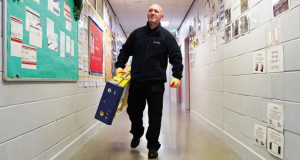New technology is transforming the way premises are kept secure – but it also raises issues of compliance with the law and codes of practice
The evolution of technology in the security sector has been rapid, delivering a level of sophistication unthinkable 10 years ago. Developments such as automatic number plate recognition and intelligent video analytics, combined with mobile technology and the interconnection made possible by the internet of things (IoT), has put unprecedented functionality and levels of control in the hands of the facilities manager. Literally.

Another significant benefit for facilities managers, he argues, is the fact that security can now also be integrated with other building systems. This means they can monitor fire alarms, sensitive plant alarms and integrated mechanical and electrical systems along with images from CCTV.
ACCESS CONTROL
A key function of security is to allow or deny access to a site as required. This can be done at a fairly basic level through the use of swipe cards (or contactless cards), or through much more complex biometric systems, depending on the sensitivity of the property in question. In areas requiring high levels of security, options such as iris scanners or fingerprint readers – that once seemed like something from a Bond movie or science fiction – are now available.
Where it’s not a case of limiting who accesses a site, but rather what they are attempting to bring in or take out, then body scanners and x-ray machines are no longer limited to airports. They can be installed in a variety of facilities and can prove invaluable.
The best news for FMs is that these electronic options don’t require someone on site to operate them. They can be controlled from remote security centres, meaning that security is available 24 hours a day, seven days a week.
SECURITY APPS
Jason Choy, founder of security consultancy Welcome Gate, reckons the rise of the security app has been a significant boon to the sector.
“In my first role working for an FM company in London, my job was to trial the very first Blackberries – yes, the black and white ones,” he says. “The fact they were so simple was what won them so much loyalty. The trial was so successful that it was near impossible to have all the units returned at the end of the trial – never had I seen a piece of technology so quickly adopted. Fast-forward 17 years and today we cannot be without our phones – they are definitely an extension of our physical, mental and social beings, with some people spending a third of their waking hours using them.”
Apps are now available for practically everything, and safety and security is no exception. These, says Choy, have three key advantages for FMs.
First, they provide peace of mind, giving FMs the power to interact with critical systems 24/7 from a handy device. Second, they are convenient – once the technology is set up, it facilitates flexible working, allowing the FM to stay on top of the latest developments and interact with the security system. Finally, with information and evidence readily available, it provides a higher degree of control.
Choy points out that although security systems have become more complex as users’ needs and expectations have increased, the growing use of apps means that manufacturers are simplifying the user experience while maintaining the necessary functionality. For example, apps are replacing traditional access cards as a means of entry. In many ways they are better than a card – if someone picked up your phone, they would still need your PIN, fingerprint or face to be able to activate it in the first place.
Best of all, people seldom leave home without their phone, and should it ever go missing, people are more likely to report it than admit they have lost their entry card. Even visitors can be sent their own personalised visitor pass so their phone can activate entrance barriers or turnstiles, even lifts. This seamless approach simultaneously lets the host know their visitor has arrived and reduces the burden on reception.
Another advantage is that out-of-hours contractors don’t need to be given a card to gain access to a building – they can simply download an app to let them in. This cuts out the need to physically give someone a card and make sure someone is on site to programme it.
“Most FMs are constantly on the go and rarely at their desk,” explains Choy. “With these apps, they don’t need to be – they can sort out all your security issues on your phone, and if they set up the triggers and alerts, they’ll only ever be notified if there is an issue. As FMs take on responsibility for an ever-increasing number of locations, technology gives them the advantage of presence and awareness without the need to be physically on site.”
Another change, he says, is in how FMs handle evacuations. Whereas in the past they would take the visitor book to the muster point and check everyone off, now it’s possible to use an access control and visitor management app to check people off, with each member of the team using their own devices, updating in real time across all locations. “These will also enable them to keep all staff updated about the latest situation, whether they are in the building, on their way to the office or working from home. Best of all, they can even mark themselves ‘safe’ – particularly useful for remote workers or a globally distributed team.”




